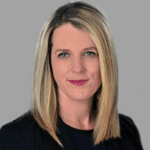
[Editor’s Note: This interview with Jennifer Gallo, a newly minted EVP, client engagement and business development, Evoke KYNE, was conducted in late December as the country was beginning to deal with the Omicron variant. The reality of entering a third year of the pandemic seemed inevitable. Instead of thinking of the holidays, people were concerned and confused. Horror stories about Omicron as well as narratives urging calm were the fare. In New York, where cases spiked, several Broadway shows, after having recently reopened, closed. And home test kits became March 2020’s version of toilet paper and hand sanitizer.
It was in this difficult communication moment that Gallo presciently prescribed flexibility for fellow communicators, as they struggled with return-to-work messages. In addition, she urged prompt messaging and transparency. Tell your audience what you know now, even if it’s incomplete. Be open about what you don’t yet know, Gallo added. She also shared tips about ‘translating’ complicated health and science information for non-scientists. The keys include making content clear, concise and accessible on several levels. She also touched on the importance of health equity. Her comments were lightly edited.]
PRNEWS: Signals about COVID-19 seem mixed. What we know now about COVID and Omicron may change in a week. As a healthcare communicator, what do you recommend PR pros outside healthcare do as some of them prepare for January return-to-office messaging?

Jennifer Gallo: You’ve hit on the biggest thing we need to be preparing for, which is we don’t know what’s going to happen next. If the last two years…or the last two weeks with Omicron has taught us anything, it’s that we don’t know what’s coming next.
What we know is we have to remain flexible…And when it comes to communicating health news to consumers, to patients or to your staff, transparency, especially during the pandemic, has been crucial.
With COVID, there’s a lot of uncertainty, about testing, about returning to work. There are a lot of factors. So, being open and honest about what you know now, and also what you don’t know now is really essential to building trust and confidence with audiences.
PRNEWS: Some communicators wait until they have a full set of facts before they compose a message.
Gallo: Yes, it seems easier to do that. But what we’ve witnessed is that a consistent cadence of updates can be really helpful and give people whatever level of confidence they can have in the pandemic right now.
PRNEWS: Speaking of the public’s confidence in science and the government, to some it appears that this new Omicron variant caught the experts flat-footed.
Gallo: I’m not going to pretend I’m an expert on the science [behind the decisions we’re seeing on COVID]...
What has been difficult to prepare for, and respond to, is this idea that people want science to be very cut and dried, very black and white. When we hear about science, we think about facts.
[But] we have to be responsible about how we communicate when it comes to science. As much as we would like [science] to respond immediately, as much as we would like to have all the information and not have it change…things change, sometimes, as you said, from day to day.
PRNEWS: That makes communicating difficult.
Gallo: Yes. [One problem is] people want to plan and they want to know what’s coming. That inability [of science] to predict, because this is a new virus, that’s been a real challenge.
I go back to the idea of transparency; explaining how the science works, how you’re deciding. When we’ve seen…people be the most transparent, when they’ve had really good explanations about how they get data and how they’re evaluating them is when they are most successful [at communicating].
PRNEWS: Sometimes scientific communication seems anything but transparent. It’s often dense, loaded with jargon and seems intentionally unintelligible to the general reader. As a specialist in patient and community communication, you must do a lot of translating of science for the rest of us.
Gallo: Yes, absolutely. It’s one of the biggest things we, as communicators, are tasked with. Listen, there’s nothing like reading a COVID publication to make you question your scientific ability if you’re not a virologist.
PRN: Oh, yes. So much of what we’ve seen is confusing.
Gallo: Right. It’s not just enough to put information out there. If it’s not accessible, [it’s not useful to a lot of people].
For example, if it’s in a peer-reviewed journal and people don’t have a subscription, it’s not accessible to them. And if they don’t have the background, they can’t understand it. Also, if it’s 20 pages long, you don’t have the time [to read it].
When you talk about accessibility, you also have to layer in captioning and translations. And if the information is on digital channels, you have to think about broadband access.
Where I think [communicators] can be most successful is making [science and health] clear, concise and relatable. And then…getting it out there on accessible channels and with someone that your audience respects and trusts. And someone your audience sees reflecting their experience.
PRN: The message and the messenger are critical.
Gallo: Yes. I love Dr. Fauci. In Fauci we trust. But he may not be relatable for a 20-year-old who comes from a different background than him. So, maybe work with someone who’s had COVID…to help people understand the reality of the situation.
Or, if you can talk with nurses and doctors on the front line, you can help people really put their mindset into why we all need to be protecting ourselves. Once you get that story in a good place, the method and mode and deliverer of the message is just as important.
PRN: Agreed. So, why did several hospitals and health providers order doctors and nurses not to talk to the media about their experiences with COVID? There were reports of doctors who were fired for speaking with the media early in the pandemic.
Gallo: Given I was not involved and don’t know the specifics of these situations, it’s not appropriate for me to comment.
PRN: What are some other best practices?
Gallo: No matter what we’re talking about, COVID, oncology, HIV, there’s a scientific story. And the vast majority of folks we’re talking to don’t come from a [science] background. So, what I love to see is when [health communicators] break things down differently for different people.
PRN: For example?
Gallo: Everyone learns differently. So, that’s creating an animation [for visual learners] or using analogies, or, as you said, using clearer language. We have some fantastic MDs and PhDs who break [science] down for us so we can break it down for our creative team [and communicate it well]. That’s really beneficial.
There’s also that one scientist at a company who’s really good at explaining [science and medicine]. If you can find that [person], it’s a golden ticket, because then you get the credibility…of discussing the data right from the source.
PRN: Health equity is a term we’re hearing a lot. What does it mean? And what’s your take on improving it for underserved communities?
Gallo: We need to be prioritizing how we can change the underserved in terms of care, but also those with mistrust in the health system and those who lack access to credible information. It’s a huge issue. To think you can solve it with one project in one year is short-sighted.
One thing we’ve done is focus on representation. So, for example, people who are telling their story on social media. [These advocates] say they’re doing this is because they want a young Black kid in LA to get health information about COVID from someone who looks like him. Who can put it into context for him. So, we must have diverse voices.
But also, what do we mean by diverse voices? It’s not just making sure you have representation based on race and ethnicity. There’s also gender identity and sexual orientation, physical ability and accessibility.
It’s also [diversity in] our account teams and our vendors. They’ll bring a richer perspective that will feel like me to more people.
So, the more voices we can include…we can begin to round out a conversation that historically has been much narrower.
When you put a person who’s lived the experience out there as the storyteller, I think that’s when you find a lot of success.
